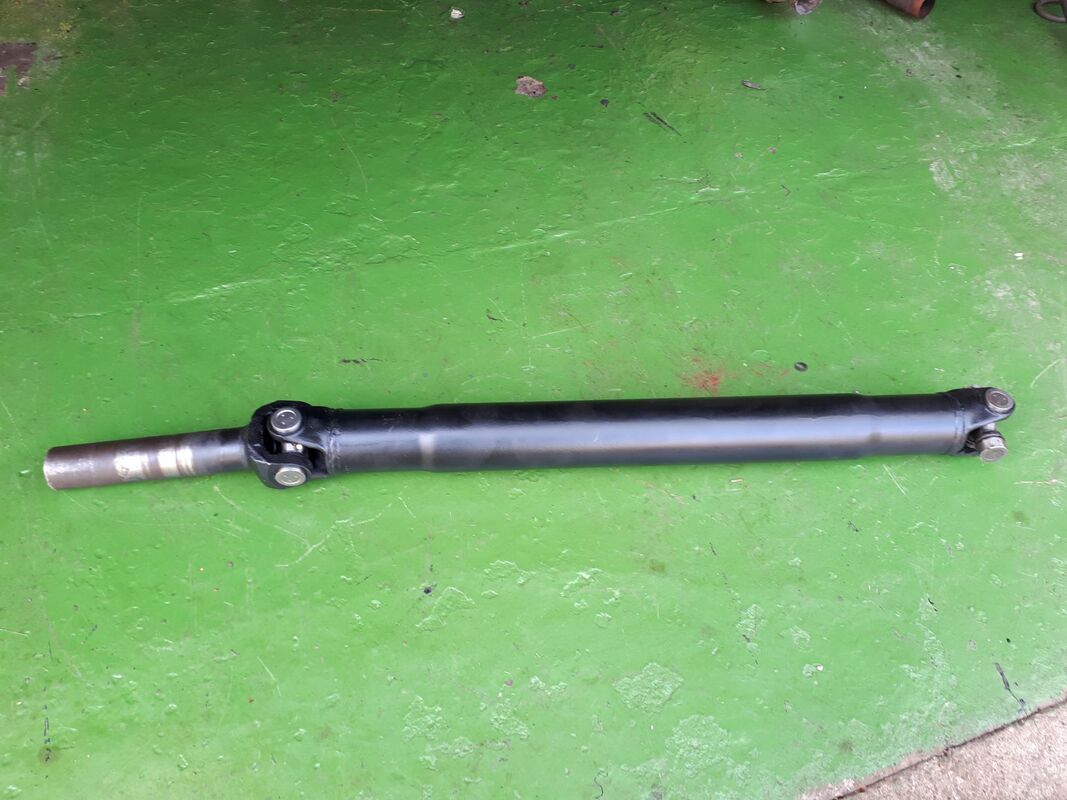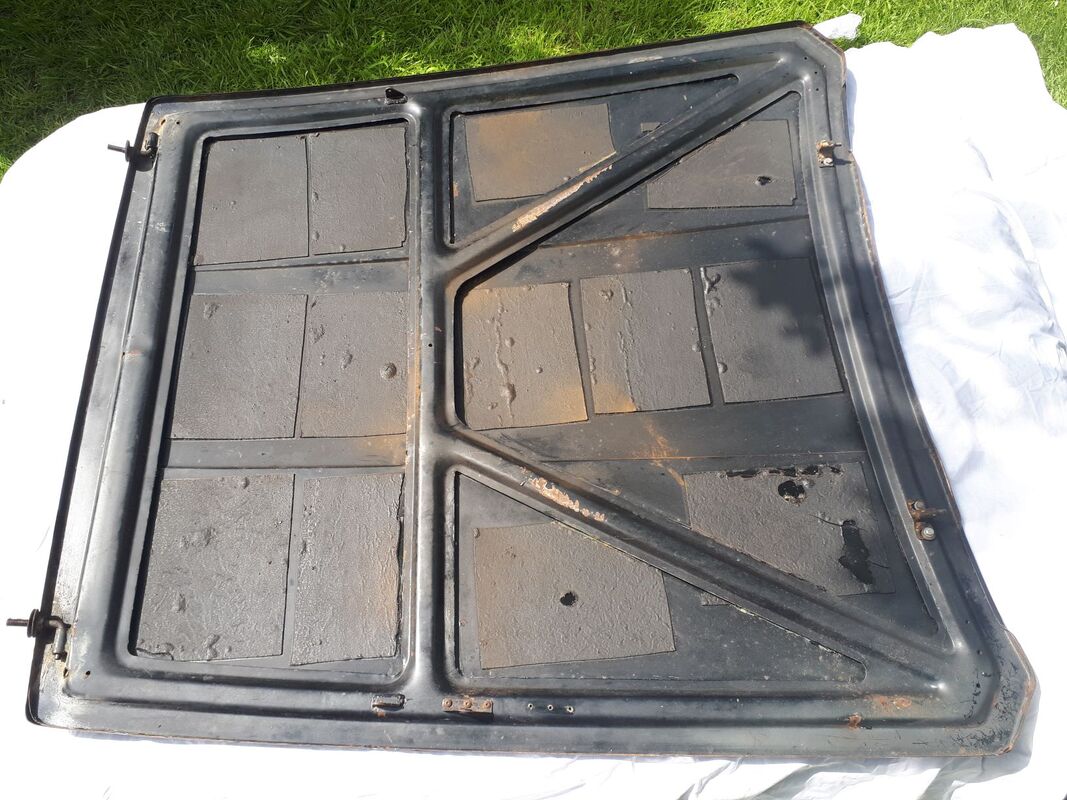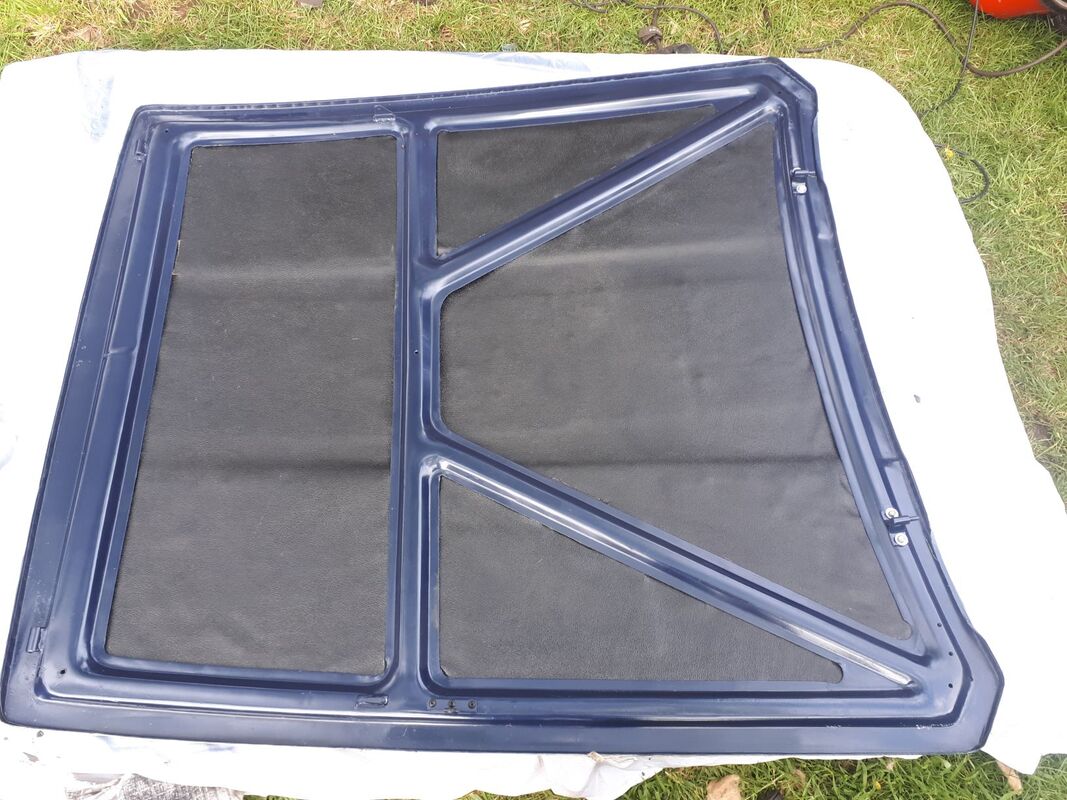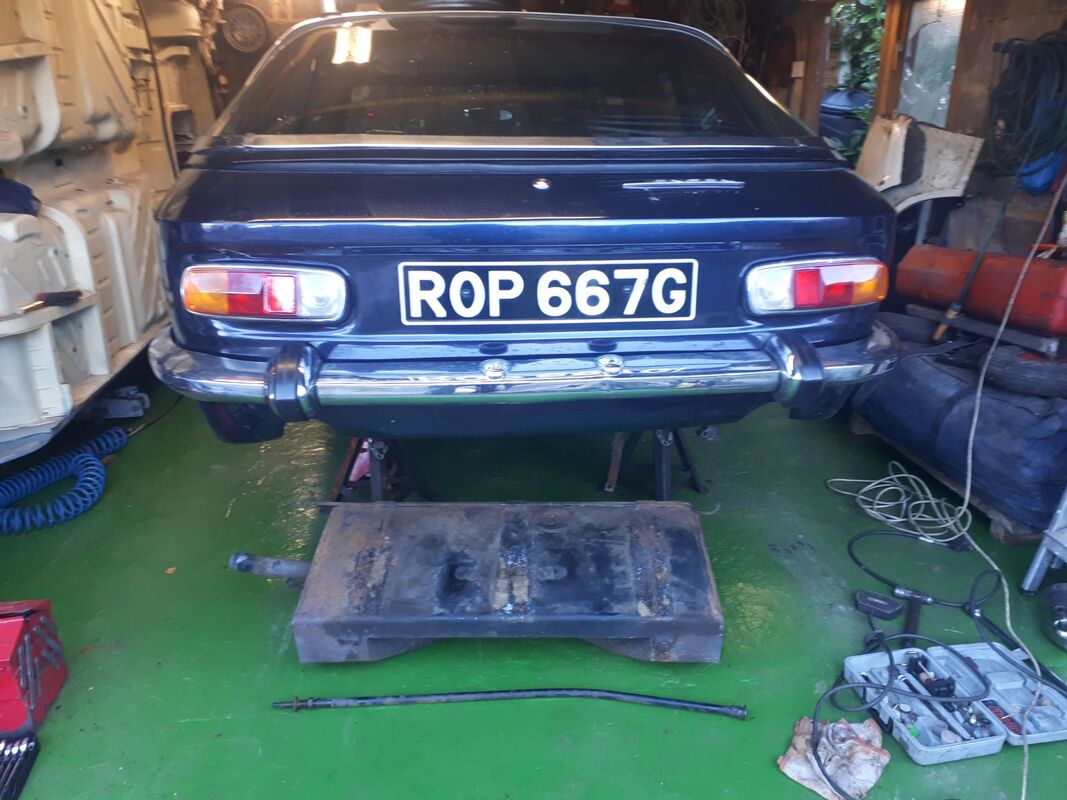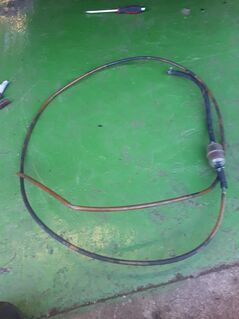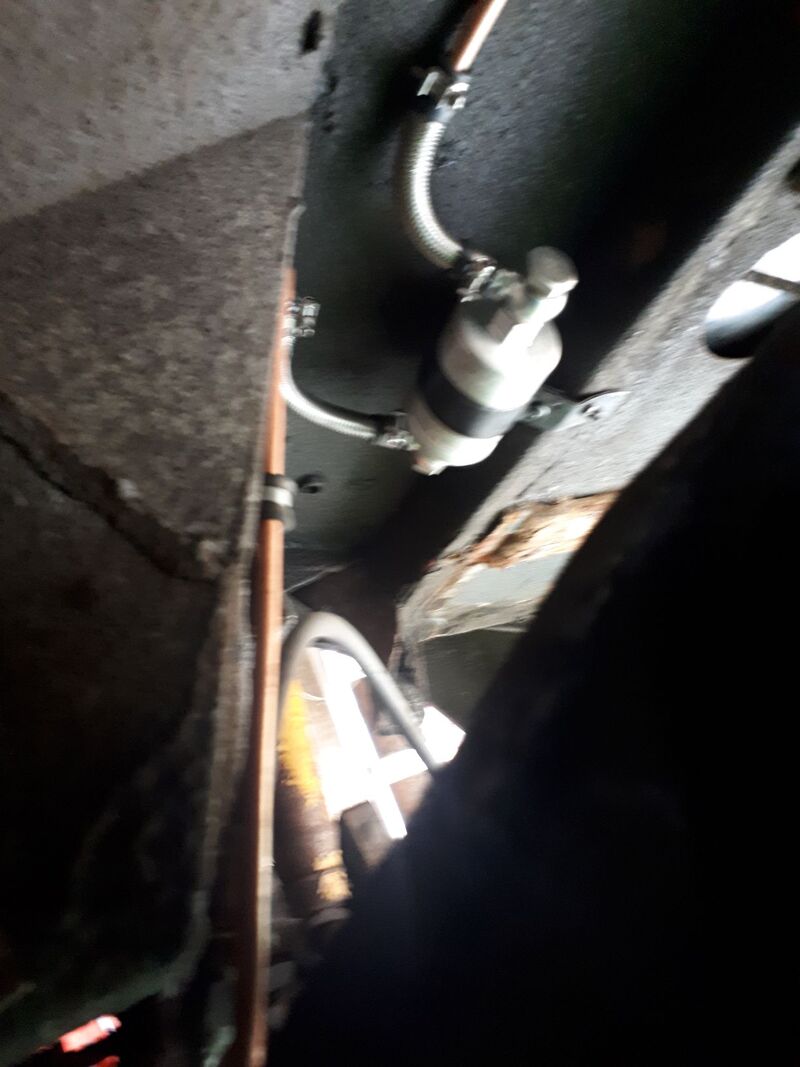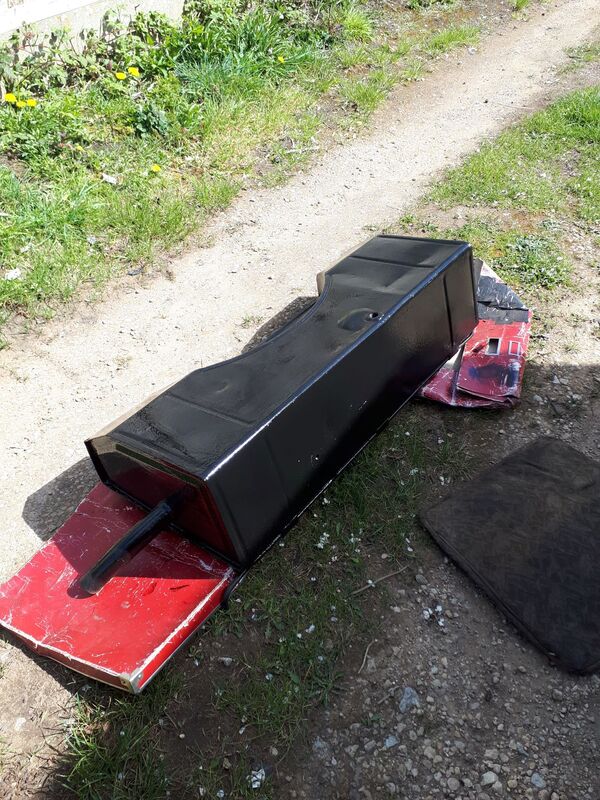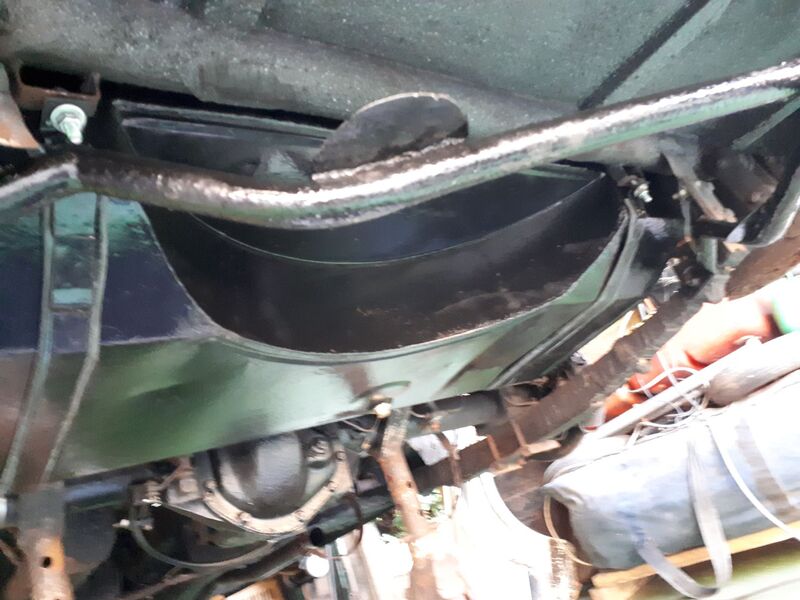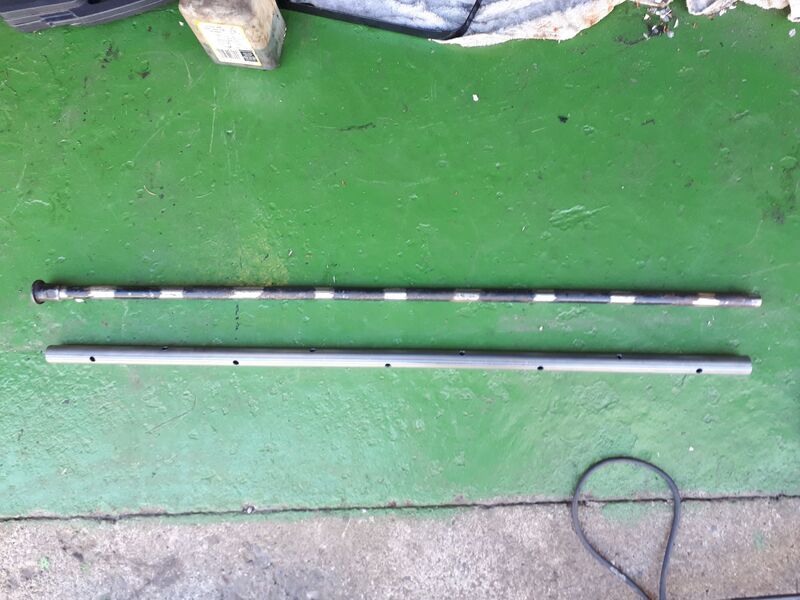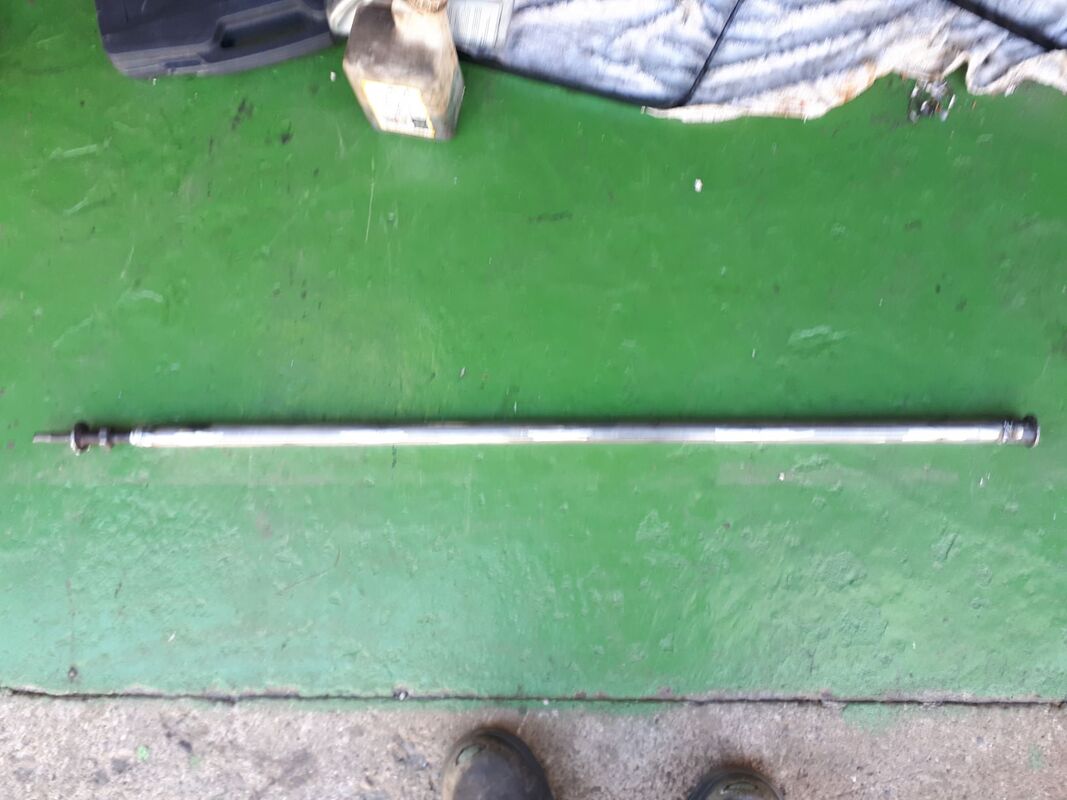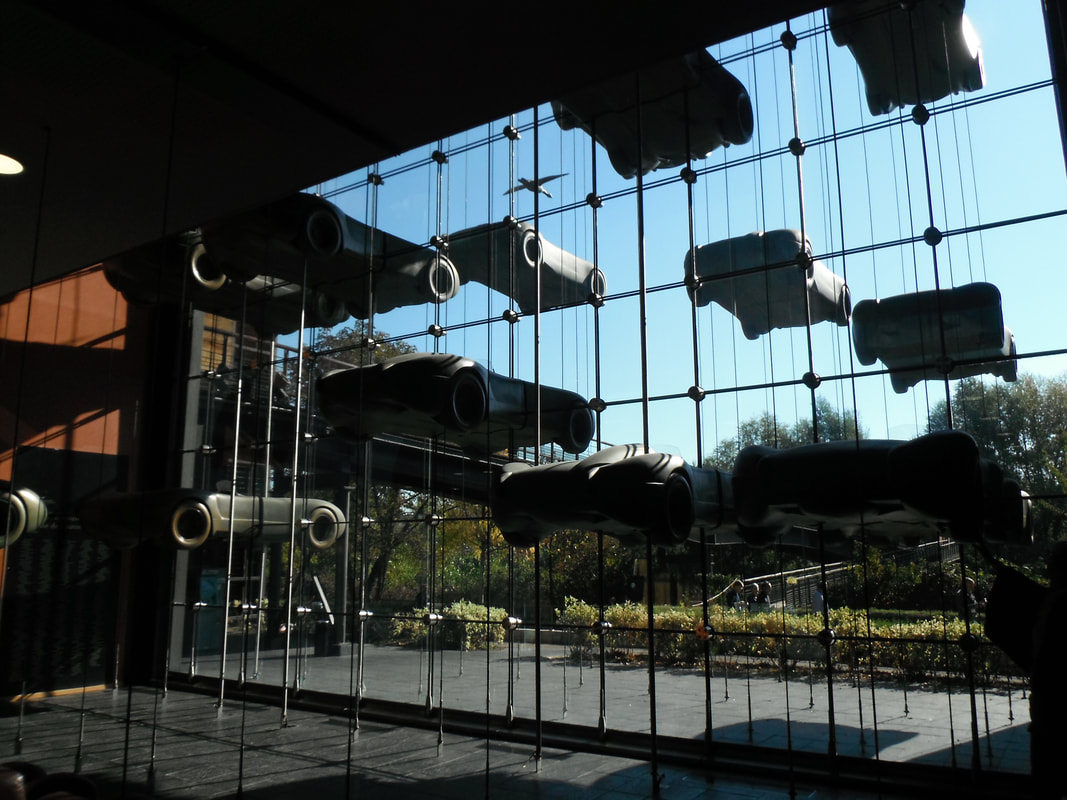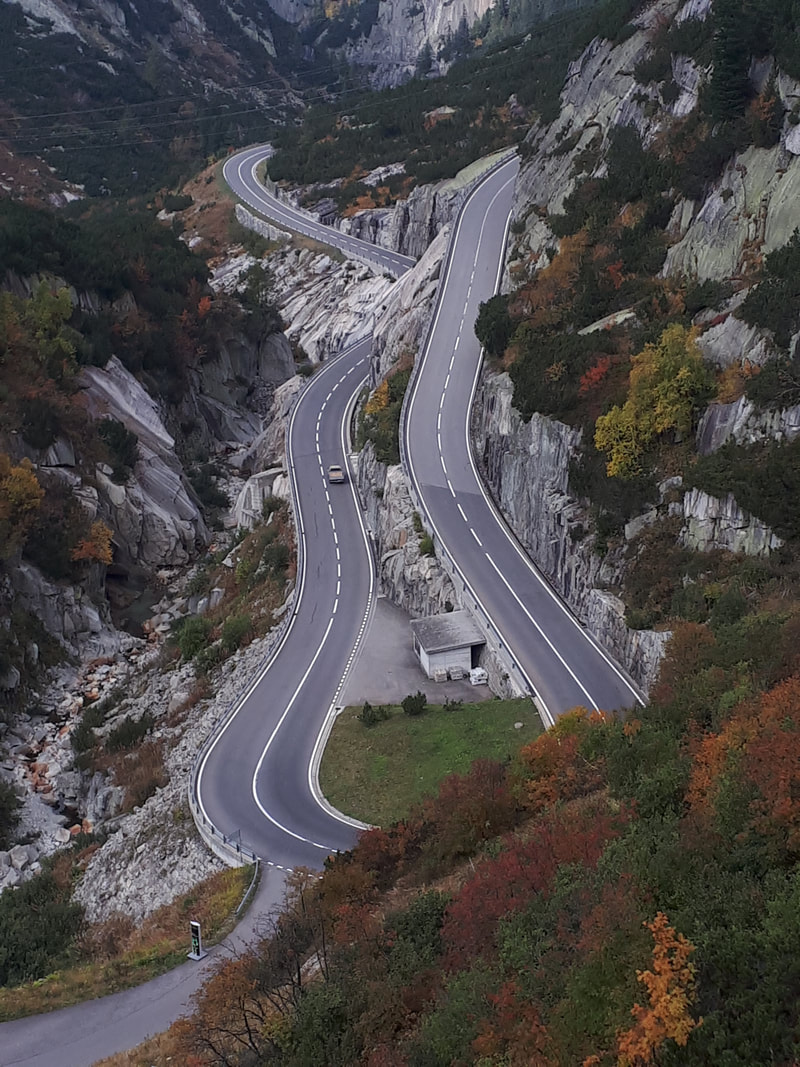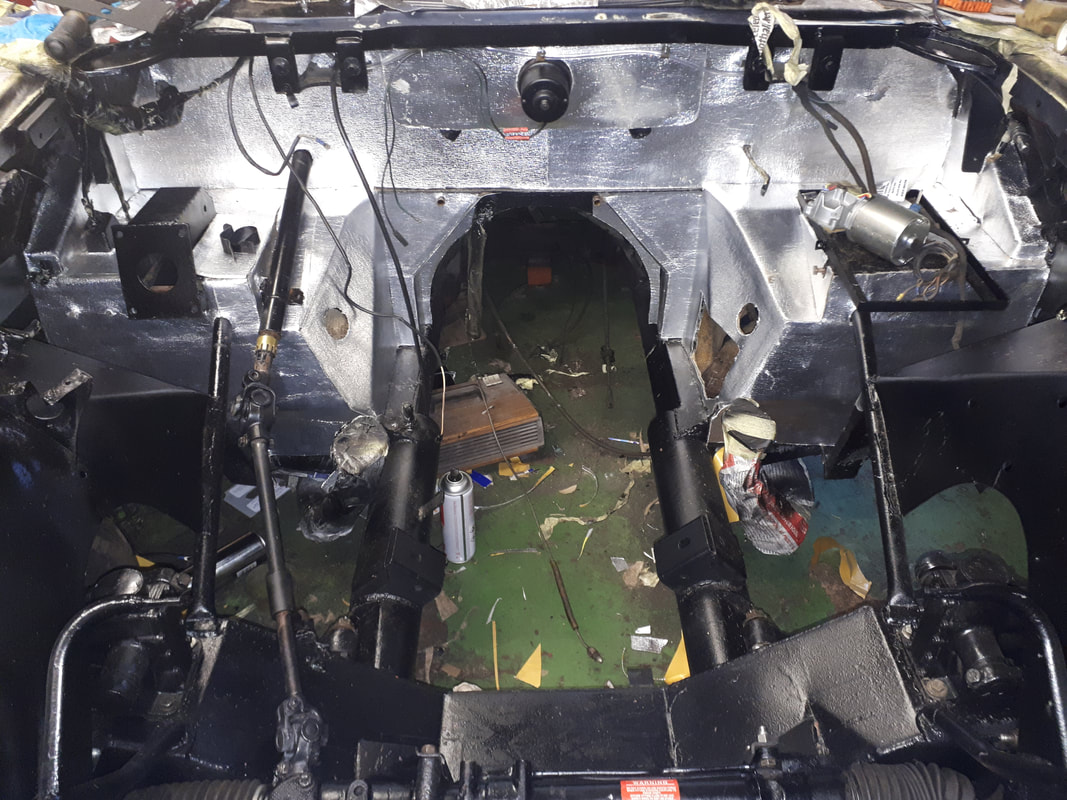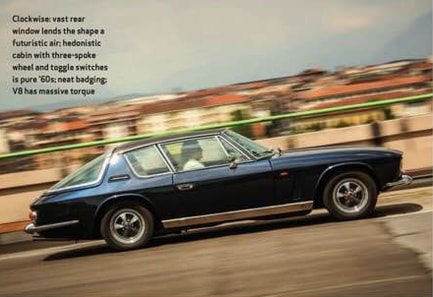Jensen Interceptor 1968 Mk1
Kevin Birch
2020 Kevin Does a bit More
I have been doing a bit more on the car, firstly have rebuilt the prop shaft as the UJs were past their best to put it mildly. The new exhaust arrived and now has been put on, I didn't realise the old exhaust was a bit of a Frankenstein system, made of bits bent to fit. By comparison the new system just slotted in, and has straight through silencers, which gives the car a nice rumble.
Since rebuilding the engine and engine bay, the underside of the bonnet has always let it down. I have now remedied this by painting it and putting Hardura, which lines the engine bay, between the cross-bracing. The blue is slightly lighter than it should be, I will get a better match, but is a vast improvement over what it was
Since rebuilding the engine and engine bay, the underside of the bonnet has always let it down. I have now remedied this by painting it and putting Hardura, which lines the engine bay, between the cross-bracing. The blue is slightly lighter than it should be, I will get a better match, but is a vast improvement over what it was
Kevin Birch, Chairman is busy working and doing things in his Garage
Doing stuff whilst off
It all started with the decision to replace the fuel lines on the Jensen, as the old were some form of plastic that had hardened and gone brittle, and had got a cheap plastic filter right by the exhaust, which wasn't a good idea. The new pipe would be copper, with a decent filter relocated away from any heat, at the tank and braided hose for the flexi bits. So petrol tank out, which meant exhaust off, and start to remove the old pipe which wasn't difficult as most of it was held in place by cable straps. A suitable location for the filter was found, a bracket made up and new pipe accordingly bent and installed correctly, fixed to the specific chassis tabs, together with the brake pipe, using the correct clamps, which again I made. The tank was cleaned, flushed out, re-painted and put back in, after the tank straps were repaired and and new rubbers made up out of a bicycle innertube. Fresh fuel put in and the engine fired up with it's glorious rumble, did I not mention that the exhaust was still off at this point with only the down pipes connected. It sounded quite like Christian's LaFrance, but louder!
Well one job leads to another,
When I removed the tank, I noticed the Panhard rod was bent, this is the second time this has happened, and is obviously weak as it is easy to straighten. A piece of tubing was sourced to go over the rod, which was slipped over and welded up, giving it a bit more strength. Whilst under the car I also found play in the prop, and on removal one joint being virtually seized with no movement in one direction. The exhaust is well past it's best too, so a new one has been ordered together with the new UJs and will be installed when it comes.
Kind Regards
Kev
Doing stuff whilst off
It all started with the decision to replace the fuel lines on the Jensen, as the old were some form of plastic that had hardened and gone brittle, and had got a cheap plastic filter right by the exhaust, which wasn't a good idea. The new pipe would be copper, with a decent filter relocated away from any heat, at the tank and braided hose for the flexi bits. So petrol tank out, which meant exhaust off, and start to remove the old pipe which wasn't difficult as most of it was held in place by cable straps. A suitable location for the filter was found, a bracket made up and new pipe accordingly bent and installed correctly, fixed to the specific chassis tabs, together with the brake pipe, using the correct clamps, which again I made. The tank was cleaned, flushed out, re-painted and put back in, after the tank straps were repaired and and new rubbers made up out of a bicycle innertube. Fresh fuel put in and the engine fired up with it's glorious rumble, did I not mention that the exhaust was still off at this point with only the down pipes connected. It sounded quite like Christian's LaFrance, but louder!
Well one job leads to another,
When I removed the tank, I noticed the Panhard rod was bent, this is the second time this has happened, and is obviously weak as it is easy to straighten. A piece of tubing was sourced to go over the rod, which was slipped over and welded up, giving it a bit more strength. Whilst under the car I also found play in the prop, and on removal one joint being virtually seized with no movement in one direction. The exhaust is well past it's best too, so a new one has been ordered together with the new UJs and will be installed when it comes.
Kind Regards
Kev
Jensen Swiss Trip 2018

This year, there was an organised trip to Switzerland organised by the Swiss faction of the Jensen Owner’s Club. Initially I had pencilled myself onto this trip, but as it coincided with the Conservative Party Conference at work, was unsure whether I would be able to get the time off. I managed to secure my annual leave, which meant not being at work for the last day of the conference, which didn’t cause much of a problem. As some of you will remember, I had recently rebuilt my engine and gearbox, and as it had taken far longer than expected, I hadn’t really put as many miles on it as I wanted, only 600. This and the fact I was struggling to find a companion to go with, both my lads had spent their holidays with their girlfriends, in July, with deep regret, I decided not to go.
Leap forward to mid-August, I was attending a fellow Jensen owner’s 60th birthday, when the subject of the Swiss trip came up. It went something like this;
Nigel (the birthday boy): “Kev you’re doing the Swiss trip aren’t you?”
Me:” No, not now, I couldn’t get anybody to come with me, and as I’ve only got 600 miles under clock since the engine rebuild, I don’t want to be hoofing it over the Alps, and giving the bearings a hammering. Are you going?”
Nigel:” No, Sue (his wife) and I are off to the Far East for my 60th and only get back a week before the trip, she can’t get the time off, so we didn’t bother, even though I could go, being self-employed.”
At that point we both looked at each other and realised, we could both go in his car, but I knew the trip was fully booked.
Me: “I’ll give Felix (the trip organiser) a call and see what can be done.”
The trip itinery was;
Thursday 4th October; Arrive in Mulhouse, France, group evening meal.
Friday 5th; Visit the Schlumpf museum, and then travel on to Morges, Switzerland.
Saturday 6th; Display the cars at the British car show in Morges.
Sunday 7th; Drive to the Grimsel Pass; visit the hydroelectric power station,
Monday 8th; Start the return trip home at your leisure.
I contacted Felix and he said no problem with the hotels in Mulhouse or Morges, as they had overflow hotels due to the numbers, but the Grimsel hotel only had 1 twin room left, and the nearest hotel was 20 Km away.
I promptly reserved all the rooms, and let Nigel know the trip was on.
As Nigel was going to be out of the country for almost 4 weeks, he asked me if I would organise everything else, which included ferries, hotels in France for the onward and return journeys, and anything else that would be needed.
This I did, so on the Wednesday I would travel down to Watford, where Nigel lives, then on to Dover, and overnight stay in Arras, France. The return journey would see an overnight stop at Nancy, before returning home the next day.
Wednesday 3rd of October soon came around, and 9 am saw me set off to Watford in my trusty Range Rover, arriving at 11:30, where Nigel’s beautiful 1967 MK1 Interceptor was waiting, and shining nicely in the sun. His car is a very early car, the chassis number showing 150th off the line, and as the first 60 or so were built in Italy, less than 100 off the West Bromwich production line.
We set off down to Dover, and had already arranged to meet up with Andy Best at Dover, to travel together, there and back for company and in case anything untoward happens. Andy too has a Mk1 Interceptor, but a rather later one from 1969.
Leap forward to mid-August, I was attending a fellow Jensen owner’s 60th birthday, when the subject of the Swiss trip came up. It went something like this;
Nigel (the birthday boy): “Kev you’re doing the Swiss trip aren’t you?”
Me:” No, not now, I couldn’t get anybody to come with me, and as I’ve only got 600 miles under clock since the engine rebuild, I don’t want to be hoofing it over the Alps, and giving the bearings a hammering. Are you going?”
Nigel:” No, Sue (his wife) and I are off to the Far East for my 60th and only get back a week before the trip, she can’t get the time off, so we didn’t bother, even though I could go, being self-employed.”
At that point we both looked at each other and realised, we could both go in his car, but I knew the trip was fully booked.
Me: “I’ll give Felix (the trip organiser) a call and see what can be done.”
The trip itinery was;
Thursday 4th October; Arrive in Mulhouse, France, group evening meal.
Friday 5th; Visit the Schlumpf museum, and then travel on to Morges, Switzerland.
Saturday 6th; Display the cars at the British car show in Morges.
Sunday 7th; Drive to the Grimsel Pass; visit the hydroelectric power station,
Monday 8th; Start the return trip home at your leisure.
I contacted Felix and he said no problem with the hotels in Mulhouse or Morges, as they had overflow hotels due to the numbers, but the Grimsel hotel only had 1 twin room left, and the nearest hotel was 20 Km away.
I promptly reserved all the rooms, and let Nigel know the trip was on.
As Nigel was going to be out of the country for almost 4 weeks, he asked me if I would organise everything else, which included ferries, hotels in France for the onward and return journeys, and anything else that would be needed.
This I did, so on the Wednesday I would travel down to Watford, where Nigel lives, then on to Dover, and overnight stay in Arras, France. The return journey would see an overnight stop at Nancy, before returning home the next day.
Wednesday 3rd of October soon came around, and 9 am saw me set off to Watford in my trusty Range Rover, arriving at 11:30, where Nigel’s beautiful 1967 MK1 Interceptor was waiting, and shining nicely in the sun. His car is a very early car, the chassis number showing 150th off the line, and as the first 60 or so were built in Italy, less than 100 off the West Bromwich production line.
We set off down to Dover, and had already arranged to meet up with Andy Best at Dover, to travel together, there and back for company and in case anything untoward happens. Andy too has a Mk1 Interceptor, but a rather later one from 1969.
The trip to Dover was uneventful, and after meeting Andy, and catching the ferry, we set off for our overnight stop in Arras, just over an hour from Calais. This was my first stint at driving Nigel’s car, and I soon became aware of quite a number of subtle differences between his car and mine. Such things as opening quarter lights, no brake/handbrake or oil pressure warning lights, and the indicator tell tales being slightly obscured by the rev counter and speedo. This was obviously addressed by the time my car was built as they are closer together. It also had vinyl seats, against the later leather ones, so I pointed out that in my car, being leather; there was a better class of sweatiness when it gets hot.
The next morning after typical continental breakfast, we set off to Mulhouse, and the start of many refuelling stops. The journey being uneventful, with the French auto routes and Route Nationals being quiet and allowing us to maintain an 80MPH average. We filled up again at Mulhouse for the next day, and had managed to put in £220 of finest 98 RON that day.
This was where the trip proper began; we entered the hotel underground carpark, and were met with numerous Jensens of all types. CV8s, 541s, Jensen Healeys, FFs, Interceptors of all MKs and types, and a few other interesting vehicles, who’s owners had Jensens that were not roadworthy at the time. These included a Jaguar E-type V12, Jaguar XK150s and a Reliant Scimitar. Some 40 vehicles would be joining us for the trip from 11 different countries, so once again a truly international event, with 2 couples joining from Australia, but in hire cars.
That night we were all introduced to each other over dinner, where new friends were made and old friends re-acquainted.
The next morning we were off to the Schlumpf museum after breakfast. If you have never heard of it, then look it up on Wikipedia, it is a fascinating story, and a bucket list experience.
The museum has the largest collection of Bugattis in the world, 120 models, including 3 of the 6 Royals that were built. It also boasts a massive pre-war collection; including many exotica such as Hispano Suiza, Isotta Fraschini, Delage and Delahaye just to name a few, of the 500 strong collection. Early afternoon was time to depart, heading off to Morges. Jumping into 40 odd Jensen, that had been allowed into the museums grounds, rather than the carpark, to set off, bemused other visitors, who thought they may have been part of the collection.
There were different routes to Morges, we chose one of the more challenging ones, which involved little motorway, but more hilly and scenic roads, which was really the reason for the trip, to drive these GTs as they were intended.
Some great driving over twisty hairpin roads put the 51 year old car through its paces, but with little difficulty, with only one stop for a fill up.
Arriving in Morges was spectacular. The sun was shining, not a cloud in the sky, and our hotel on the banks of lake Lucerne, with loads of other British classics dotted around the town. A group evening meal was attended, with plenty of drink being consumed, and tales of the days driving experiences and what we thought of the museum. A couple of cars had experienced some issues, one FF having started to blow from one of the exhaust manifolds, to which I said I’ll have a look at the next day when the cars would be lined up for the car show.
Saturday arrived, and we had to get the cars onto the allocated space we had been given at the show. This had to be done early, as there were so many of us, and we wanted them all together, and if we left it too late, getting them all together could get difficult.
Once the cars were in place, it was a 2 minute walk back to the hotel for breakfast.
The Morges British car show is something to behold, taking place annually. A large section of the town is closed off to the public, and approximately 1500 British built cars attend. It is totally free, and you can just turn up, so long as it is British. There was everything there from Austin 7s to a Jaguar XJ220, and in all states of repair.
We had a great day, and were approached by quite a number of people wondering why we had UK number plates on many of our cars, as the majority of the cars at the show were either; Swiss, French or German. When we explained we were from the UK and on a club trip around Switzerland, and would be covering around 1600 miles in 7 days, they thought we were mad. I took some time to have a look at the FF with the blowing manifold. After checking that the nuts were tight, I undid some of the heatshield wrap, to reveal a massive crack in the cast iron, which was irreparable. A temporary fix with exhaust paste, tin can and jubilee clips managed to reduce the blow to a minimum, and after re-wrapping the heatshield made driving the car bearable. A club Barbeque was set up, and homemade Speckled Hen was consumed during the day, which turned out to be a bit lively in the magnificent heat of the day.
The next morning after typical continental breakfast, we set off to Mulhouse, and the start of many refuelling stops. The journey being uneventful, with the French auto routes and Route Nationals being quiet and allowing us to maintain an 80MPH average. We filled up again at Mulhouse for the next day, and had managed to put in £220 of finest 98 RON that day.
This was where the trip proper began; we entered the hotel underground carpark, and were met with numerous Jensens of all types. CV8s, 541s, Jensen Healeys, FFs, Interceptors of all MKs and types, and a few other interesting vehicles, who’s owners had Jensens that were not roadworthy at the time. These included a Jaguar E-type V12, Jaguar XK150s and a Reliant Scimitar. Some 40 vehicles would be joining us for the trip from 11 different countries, so once again a truly international event, with 2 couples joining from Australia, but in hire cars.
That night we were all introduced to each other over dinner, where new friends were made and old friends re-acquainted.
The next morning we were off to the Schlumpf museum after breakfast. If you have never heard of it, then look it up on Wikipedia, it is a fascinating story, and a bucket list experience.
The museum has the largest collection of Bugattis in the world, 120 models, including 3 of the 6 Royals that were built. It also boasts a massive pre-war collection; including many exotica such as Hispano Suiza, Isotta Fraschini, Delage and Delahaye just to name a few, of the 500 strong collection. Early afternoon was time to depart, heading off to Morges. Jumping into 40 odd Jensen, that had been allowed into the museums grounds, rather than the carpark, to set off, bemused other visitors, who thought they may have been part of the collection.
There were different routes to Morges, we chose one of the more challenging ones, which involved little motorway, but more hilly and scenic roads, which was really the reason for the trip, to drive these GTs as they were intended.
Some great driving over twisty hairpin roads put the 51 year old car through its paces, but with little difficulty, with only one stop for a fill up.
Arriving in Morges was spectacular. The sun was shining, not a cloud in the sky, and our hotel on the banks of lake Lucerne, with loads of other British classics dotted around the town. A group evening meal was attended, with plenty of drink being consumed, and tales of the days driving experiences and what we thought of the museum. A couple of cars had experienced some issues, one FF having started to blow from one of the exhaust manifolds, to which I said I’ll have a look at the next day when the cars would be lined up for the car show.
Saturday arrived, and we had to get the cars onto the allocated space we had been given at the show. This had to be done early, as there were so many of us, and we wanted them all together, and if we left it too late, getting them all together could get difficult.
Once the cars were in place, it was a 2 minute walk back to the hotel for breakfast.
The Morges British car show is something to behold, taking place annually. A large section of the town is closed off to the public, and approximately 1500 British built cars attend. It is totally free, and you can just turn up, so long as it is British. There was everything there from Austin 7s to a Jaguar XJ220, and in all states of repair.
We had a great day, and were approached by quite a number of people wondering why we had UK number plates on many of our cars, as the majority of the cars at the show were either; Swiss, French or German. When we explained we were from the UK and on a club trip around Switzerland, and would be covering around 1600 miles in 7 days, they thought we were mad. I took some time to have a look at the FF with the blowing manifold. After checking that the nuts were tight, I undid some of the heatshield wrap, to reveal a massive crack in the cast iron, which was irreparable. A temporary fix with exhaust paste, tin can and jubilee clips managed to reduce the blow to a minimum, and after re-wrapping the heatshield made driving the car bearable. A club Barbeque was set up, and homemade Speckled Hen was consumed during the day, which turned out to be a bit lively in the magnificent heat of the day.
Another evening meal consumed, again with plenty of beer, general banter and stories abounded throughout the group, as we were all getting to know each other by now.
Sunday was a rather relaxed drive to the Grimsel Pass, our final destination of the organised trip. This again could be tackled via different routes, and we again chose the more scenic and challenging route, avoiding motorways as much as possible, with the brief being to get to the hotel by 16:00, as the power station trip was booked for 16:30.
We set off north from Morges, jumping on the motorway which rises above and skirts Lausanne, with fantastic views across Lake Geneva, which must be one of the best motorway sections on the planet. As we passed Montreux, we exited, to head up route 11 to Spiez and Interlaken, which takes you over a national park with steep climbs and hairpin bends. The trick with these cars to stop overheating, is to keep the speed up, and so the airflow through the radiator. This means some spirited driving and throwing it into the bends. Nigel’s car had suffered from overheating 2 years previously on the Turin trip on this type of road, due to being too cautious and slowing down for the hairpins. I was driving the first stint, and Nigel was concerned about the temperature gauge, but as I was keeping the speed and momentum up, through the bends the temperature stayed down and the car performed faultlessly.
A civilised journey where we stopped for mid-morning coffee, then lunch at a roadside café whose owner had a Dodge Charger in the carpark, which has the same drive train as our cars, saw us arrive at our hotel on the Grimsell pass at around 15:00. The scenery and roads we experienced were fantastic, and what these cars were originally designed to do.
The trip to the power station was incredible, buried 3 Km into the mountainside, and consisted of 6 reservoirs all interconnected, with 2 main power stations situated along the pass. These power stations can go from zero to full output in 7 seconds, and when they started just one of the 6 turbines in the room we were in, the noise and vibrations through the floor were tremendous, so heaven knows what it would be like with all 6 spinning.
That evening was the last evening we would all be together, and as with previous evenings, a great meal was consumed with the odd beer or two. At this dinner the guest speaker was Peter Neale, a Jensen Healey owner, whose father, Eric, was Director of Engineering at Jensen from the ‘40s to the ‘60s. He fascinated us about his father’s time at Jensen and how his designs included the early 1950 Interceptor, Austin A40 Sports, Jensen 541, C-V8, and development of the Austin Healey, amongst others. After the meal, and having a few beers with what have become to be good friends over the years, Felix (one of the organisers) and I were discussing our cars. Mine an early MK1 Interceptor, and his, a late C-V8 MK3, basically the same car mechanically, but mine wears a beautiful Italian
suit. He asked me if I had ever driven a C-V8, which I hadn’t, and explaining as they were made of fibreglass, they are 300Kg lighter, with the same power output, but much more responsive. He then said he would let me have a drive of his car in the morning, so I could compare them, something I couldn’t turn down.
Next morning, up early for a trip up a funicular railway, not any one, but the Gelmar, the steepest in the world, and it is open air with just a steel bar to stop you falling out. This thing has a gradient of 109%, and like a fool I sat with another 2 mates at the front, thinking we would have a good view, as it is pulled backwards up the mountain. The track is 1028m long and as it hauls you up it gets steeper and steeper, to the point you are sliding forwards off the seat, and having to push on a wooden board to stop you sliding under the “safety” bar to slide down the 1000m beautiful view in front of you! It takes you to a lake at the top, part of the hydroelectric system we visited the day before, and the railway was built to construct the dam in 1926, not to take passengers, but the crazy Swiss found a use for it once the dam was built. On the way down, I chose to sit further back in the carriage, I’m not scared of heights, but it did un-nerve me being at the front with a 1000m drop in front of me on the way up.
Back to the hotel, for breakfast, and caught up with Felix, who asked me if I still wanted to have a go of his lovely C-V8. Thinking it was probably the beer talking the night before, I was a little surprised, but was not going to turn an opportunity like this down. After breakfast, we ambled out to his car, and he pointed out a few things I need to know, lights, horn etc. handed me the keys and said, “Go enjoy yourself.” I said, “Are you not coming?” He smiled and said, “No, I’ve been on it before”.
I gingerly eased it out the car park and headed up the Grimsel, getting used to it, thinking this car is worth 3 times mine. It has the same 6.3L V8 and 3 speed Torquflite auto box as mine, but no power steering which was well weighted with a bigger steering wheel, and being 300Kg lighter. After just
under an hour, going to the top of the Grimsel, then down and back up the Furka pass (from James Bond, Goldfinger fame) I arrived back at the hotel with a massive smile on my face. He was right, it is so much more responsive than mine, I was getting used to it and giving it some more beans towards the end of my drive, I want one!!
Sunday was a rather relaxed drive to the Grimsel Pass, our final destination of the organised trip. This again could be tackled via different routes, and we again chose the more scenic and challenging route, avoiding motorways as much as possible, with the brief being to get to the hotel by 16:00, as the power station trip was booked for 16:30.
We set off north from Morges, jumping on the motorway which rises above and skirts Lausanne, with fantastic views across Lake Geneva, which must be one of the best motorway sections on the planet. As we passed Montreux, we exited, to head up route 11 to Spiez and Interlaken, which takes you over a national park with steep climbs and hairpin bends. The trick with these cars to stop overheating, is to keep the speed up, and so the airflow through the radiator. This means some spirited driving and throwing it into the bends. Nigel’s car had suffered from overheating 2 years previously on the Turin trip on this type of road, due to being too cautious and slowing down for the hairpins. I was driving the first stint, and Nigel was concerned about the temperature gauge, but as I was keeping the speed and momentum up, through the bends the temperature stayed down and the car performed faultlessly.
A civilised journey where we stopped for mid-morning coffee, then lunch at a roadside café whose owner had a Dodge Charger in the carpark, which has the same drive train as our cars, saw us arrive at our hotel on the Grimsell pass at around 15:00. The scenery and roads we experienced were fantastic, and what these cars were originally designed to do.
The trip to the power station was incredible, buried 3 Km into the mountainside, and consisted of 6 reservoirs all interconnected, with 2 main power stations situated along the pass. These power stations can go from zero to full output in 7 seconds, and when they started just one of the 6 turbines in the room we were in, the noise and vibrations through the floor were tremendous, so heaven knows what it would be like with all 6 spinning.
That evening was the last evening we would all be together, and as with previous evenings, a great meal was consumed with the odd beer or two. At this dinner the guest speaker was Peter Neale, a Jensen Healey owner, whose father, Eric, was Director of Engineering at Jensen from the ‘40s to the ‘60s. He fascinated us about his father’s time at Jensen and how his designs included the early 1950 Interceptor, Austin A40 Sports, Jensen 541, C-V8, and development of the Austin Healey, amongst others. After the meal, and having a few beers with what have become to be good friends over the years, Felix (one of the organisers) and I were discussing our cars. Mine an early MK1 Interceptor, and his, a late C-V8 MK3, basically the same car mechanically, but mine wears a beautiful Italian
suit. He asked me if I had ever driven a C-V8, which I hadn’t, and explaining as they were made of fibreglass, they are 300Kg lighter, with the same power output, but much more responsive. He then said he would let me have a drive of his car in the morning, so I could compare them, something I couldn’t turn down.
Next morning, up early for a trip up a funicular railway, not any one, but the Gelmar, the steepest in the world, and it is open air with just a steel bar to stop you falling out. This thing has a gradient of 109%, and like a fool I sat with another 2 mates at the front, thinking we would have a good view, as it is pulled backwards up the mountain. The track is 1028m long and as it hauls you up it gets steeper and steeper, to the point you are sliding forwards off the seat, and having to push on a wooden board to stop you sliding under the “safety” bar to slide down the 1000m beautiful view in front of you! It takes you to a lake at the top, part of the hydroelectric system we visited the day before, and the railway was built to construct the dam in 1926, not to take passengers, but the crazy Swiss found a use for it once the dam was built. On the way down, I chose to sit further back in the carriage, I’m not scared of heights, but it did un-nerve me being at the front with a 1000m drop in front of me on the way up.
Back to the hotel, for breakfast, and caught up with Felix, who asked me if I still wanted to have a go of his lovely C-V8. Thinking it was probably the beer talking the night before, I was a little surprised, but was not going to turn an opportunity like this down. After breakfast, we ambled out to his car, and he pointed out a few things I need to know, lights, horn etc. handed me the keys and said, “Go enjoy yourself.” I said, “Are you not coming?” He smiled and said, “No, I’ve been on it before”.
I gingerly eased it out the car park and headed up the Grimsel, getting used to it, thinking this car is worth 3 times mine. It has the same 6.3L V8 and 3 speed Torquflite auto box as mine, but no power steering which was well weighted with a bigger steering wheel, and being 300Kg lighter. After just
under an hour, going to the top of the Grimsel, then down and back up the Furka pass (from James Bond, Goldfinger fame) I arrived back at the hotel with a massive smile on my face. He was right, it is so much more responsive than mine, I was getting used to it and giving it some more beans towards the end of my drive, I want one!!
After handing Felix the keys back it was time to start the return journey, many Jensonites had already left, and it was only a few of us left, we were having such a good time we didn’t want to leave. We said our goodbyes, Nigel and I were also joined by Andy. We set off heading for Nancy, our overnight stop in France on the Monday night.
The trip to Nancy was uneventful, just really good driving on Swiss roads through the Alps on twisty sections, and the motorways into France.
Tuesday saw us up early, as we had a 500 mile drive back from Nancy to Watford through France. A fill up first thing and off we set after breakfast, once again generally uneventful, driving good Route National and Auto Routes through France. Stopping at St Quentin for lunch, and a refill of fuel with a last dash to Calais for the ferry. We maintained a steady 80 MPH all the way, which the car did with ease. Off the ferry at Dover, a final fill up, which accounted for £250 worth of fuel put in that day, although not all would be used, and farewell to Andy who would be going his own way. We made good time on the M20 and M25, and as we came off the motorway at J21, Watford, in the dark, we approached the island to a loud squealing noise from under the bonnet and a burning rubber smell. Looking at the ammeter, it would appear that the alternator was not charging, and the fan belt was obviously the cause of the noise. Nigel was driving, so I told him to just drive on side lights, and not to use indicators, we should be fine to get the 3 miles back to his house, just on the battery. On arriving home we opened the bonnet to find the alternator had seized, which considering we had just covered 500 miles at 80MPH, and hoofed it over some demanding roads in the past week, this being the only issue, wasn’t too bad a result from a 51 year old car.
The car averaged 16 Mpg overall, but as low as 11Mpg through the Alps, used half a gallon of oil, and half a litre of ATF, as the auto box has a small leak.
2019, there is a weekend tour Devon being organised, with a trip to Norway looking likely in 2020, so watch this space.
The trip to Nancy was uneventful, just really good driving on Swiss roads through the Alps on twisty sections, and the motorways into France.
Tuesday saw us up early, as we had a 500 mile drive back from Nancy to Watford through France. A fill up first thing and off we set after breakfast, once again generally uneventful, driving good Route National and Auto Routes through France. Stopping at St Quentin for lunch, and a refill of fuel with a last dash to Calais for the ferry. We maintained a steady 80 MPH all the way, which the car did with ease. Off the ferry at Dover, a final fill up, which accounted for £250 worth of fuel put in that day, although not all would be used, and farewell to Andy who would be going his own way. We made good time on the M20 and M25, and as we came off the motorway at J21, Watford, in the dark, we approached the island to a loud squealing noise from under the bonnet and a burning rubber smell. Looking at the ammeter, it would appear that the alternator was not charging, and the fan belt was obviously the cause of the noise. Nigel was driving, so I told him to just drive on side lights, and not to use indicators, we should be fine to get the 3 miles back to his house, just on the battery. On arriving home we opened the bonnet to find the alternator had seized, which considering we had just covered 500 miles at 80MPH, and hoofed it over some demanding roads in the past week, this being the only issue, wasn’t too bad a result from a 51 year old car.
The car averaged 16 Mpg overall, but as low as 11Mpg through the Alps, used half a gallon of oil, and half a litre of ATF, as the auto box has a small leak.
2019, there is a weekend tour Devon being organised, with a trip to Norway looking likely in 2020, so watch this space.
Jensen Interceptor Engine Rebuild, Kevin Birch 2018

My Jensen Interceptor Gearbox Oil Seal Replacement.
Some of you may have noticed my poor attendance on a Thursday evening, and at events, which has mainly been due to heavy work load, and any spare time being used on getting my Jensen back on the road. From the account I did of the Dresden trip in September you may remember I blew an oil seal on the gearbox whilst doing some spirited driving up a mountain on the German/Czech border.
For those that are not aware, after climbing a mountain at speed and parking up at Fichtelberg 1214m above sea level, for lunch, it was pointed out that quite a bit of oil was being deposited on the floor. After consulting one of the Jensen Owners club members, who subsequently rebuilt my gearbox, suggested keeping the engine below 2500 PRM, preferably as low as 2000 RPM, and see what happens as the front gearbox oil seal had failed. I was grateful for various members donating 6 litres of Dexron 2 to keep my box topped up. Keeping the revs down ensured minimal leakage, and I managed a steady drive home without incident .Well this £25 oil seal has resulted in the gearbox being rebuilt, torque converter replaced, engine rebuilt and engine bay refurbished.
To get the gearbox out, the engine has to come out, which was a major undertaking. I have a good engine hoist but even that wouldn’t reach far enough into the engine bay to lift the 400 KG engine which is set well back against the bulkhead. Block and tackle was the only way of lifting it safely, even then having that amount of weight swinging on a chain is a bit scary. Once out, the gearbox was a simple affair and that was on the floor within half an hour. The gearbox and torque converter was dispatched to be rebuilt, to which the rebuilder thought the converter was off a dead car as it was in such a poor state. He couldn’t believe I’d just been to Germany and back with it.
I took this opportunity to have a look at the engine, even though it appeared to be running well, I didn’t want to have to get it out again in the near future. On strip down all appeared quite good, mains and big ends were in good condition, requiring new bearings only. Cam shaft in good condition, but some followers were past their best. Pistons and bores appeared good so new rings only. The heads were a different story, with severe valve seat recession on the exhaust ports. This had been masked by the hydraulic tappets which had self adjusted, so both heads were machined for hardened seats. Lots of new parts ordered, including oil pump, oil pump drive and electronic distributor with bores being honed awaiting reassembly.
Now putting a rebuilt freshly painted engine back in a dirty tired engine bay won’t do. So I stripped the bay of every component, then set about the Hardura (vinyl covered matting) that lines part of the engine bay and bulkhead. Following that was to remove the original stone chip which coated the rest of the bay. This is where I found a couple of plates riveted in place over the rusty original panels, which were promptly cut out and new metal welded in. The air intake box on the bulkhead was rotten and the whole bottom of it had to be made from scratch, the removal of this gives access to the scuttle grill which was in a poor painted state, and should be polished aluminium.
So the engine bay now stripped and ready for the stone chip coating, which is then followed by a couple of coats of satin black. Templates were made up for the Hardura, which is covered in aluminium heat shielding along the bulkhead and foot wells, and all duly stuck on over about 2 weeks. All under bonnet components were repainted satin black, and all nuts and bolts replaced with new items.
I was so busy sorting the engine bay, all the engine parts had been collected and were sitting waiting to be installed. Having checked all new parts to ensure they’re within tolerance, the assembly started, only to come to an abrupt halt. On installing the new piston rings, I found the oil control ring was tight and not seating properly on one piston. Suspecting just a bit of carbon that I’d missed, on closer inspection I found a small crack in the piston, causing the groove to close up slightly. A full set of pistons would now be required, which proved difficult to locate. Every body had standard bore, but mine were 30’ over size, and nobody appeared to have any on the shelf, and were on back order from the states, with an estimated delivery of late April to early May, and this was mid February. Three weeks of searching finally turned up a set, probably the only ones in the UK!!
Engine was then finally rebuilt, painted and ready to install, after the gearbox went back in. Drive it day was the only day off I had to install it, so it was either that or join you all at Chateau Impney, I chose the former. By 17:00 it was in, and with oil in it and enough connections to see if it would turn over, and get the oil pressure up. I turned the key and nothing. On further investigation, the starter relay had gone south, so bypassed, she turned over, quite quickly attaining an oil pressure of 60 PSI just on the starter. I put the plugs in, and went for a start, she fired first time and sounded glorious as only a 6.3L engine can with no exhaust connected!
A few days later I had connected the radiator and exhaust etc for a full start, which entails taking it to 2000 RPM and keeping it there for 20 minutes, to work harden the valve train, otherwise the cam followers won’t last above 1000 miles.
After fettling everything, and hitting a few snags such as brake servo failure, one of the electric fans failing, and struggling to get all the air out of the front callipers,( that was a saga on its own) the car was finally ready at 23:00 on Friday 4th May, for its first drive on May 5th to Droitwich. I’m pleased to say she went well, a couple of dribbles of water, which have now been sorted, but she could really do with a good tune up.
I still have the electronic ignition to fit, but the wiring has been discreetly installed, and I have also purchased 2 oil coolers for the engine and gearbox, which I will be installing soon, as I didn’t get time to do during the strip down.
So a £25 oil seal has now cost me well into 4 figures, and I can now see how some people take a bolt out and end up with a full restoration on their hands.
Some of you may have noticed my poor attendance on a Thursday evening, and at events, which has mainly been due to heavy work load, and any spare time being used on getting my Jensen back on the road. From the account I did of the Dresden trip in September you may remember I blew an oil seal on the gearbox whilst doing some spirited driving up a mountain on the German/Czech border.
For those that are not aware, after climbing a mountain at speed and parking up at Fichtelberg 1214m above sea level, for lunch, it was pointed out that quite a bit of oil was being deposited on the floor. After consulting one of the Jensen Owners club members, who subsequently rebuilt my gearbox, suggested keeping the engine below 2500 PRM, preferably as low as 2000 RPM, and see what happens as the front gearbox oil seal had failed. I was grateful for various members donating 6 litres of Dexron 2 to keep my box topped up. Keeping the revs down ensured minimal leakage, and I managed a steady drive home without incident .Well this £25 oil seal has resulted in the gearbox being rebuilt, torque converter replaced, engine rebuilt and engine bay refurbished.
To get the gearbox out, the engine has to come out, which was a major undertaking. I have a good engine hoist but even that wouldn’t reach far enough into the engine bay to lift the 400 KG engine which is set well back against the bulkhead. Block and tackle was the only way of lifting it safely, even then having that amount of weight swinging on a chain is a bit scary. Once out, the gearbox was a simple affair and that was on the floor within half an hour. The gearbox and torque converter was dispatched to be rebuilt, to which the rebuilder thought the converter was off a dead car as it was in such a poor state. He couldn’t believe I’d just been to Germany and back with it.
I took this opportunity to have a look at the engine, even though it appeared to be running well, I didn’t want to have to get it out again in the near future. On strip down all appeared quite good, mains and big ends were in good condition, requiring new bearings only. Cam shaft in good condition, but some followers were past their best. Pistons and bores appeared good so new rings only. The heads were a different story, with severe valve seat recession on the exhaust ports. This had been masked by the hydraulic tappets which had self adjusted, so both heads were machined for hardened seats. Lots of new parts ordered, including oil pump, oil pump drive and electronic distributor with bores being honed awaiting reassembly.
Now putting a rebuilt freshly painted engine back in a dirty tired engine bay won’t do. So I stripped the bay of every component, then set about the Hardura (vinyl covered matting) that lines part of the engine bay and bulkhead. Following that was to remove the original stone chip which coated the rest of the bay. This is where I found a couple of plates riveted in place over the rusty original panels, which were promptly cut out and new metal welded in. The air intake box on the bulkhead was rotten and the whole bottom of it had to be made from scratch, the removal of this gives access to the scuttle grill which was in a poor painted state, and should be polished aluminium.
So the engine bay now stripped and ready for the stone chip coating, which is then followed by a couple of coats of satin black. Templates were made up for the Hardura, which is covered in aluminium heat shielding along the bulkhead and foot wells, and all duly stuck on over about 2 weeks. All under bonnet components were repainted satin black, and all nuts and bolts replaced with new items.
I was so busy sorting the engine bay, all the engine parts had been collected and were sitting waiting to be installed. Having checked all new parts to ensure they’re within tolerance, the assembly started, only to come to an abrupt halt. On installing the new piston rings, I found the oil control ring was tight and not seating properly on one piston. Suspecting just a bit of carbon that I’d missed, on closer inspection I found a small crack in the piston, causing the groove to close up slightly. A full set of pistons would now be required, which proved difficult to locate. Every body had standard bore, but mine were 30’ over size, and nobody appeared to have any on the shelf, and were on back order from the states, with an estimated delivery of late April to early May, and this was mid February. Three weeks of searching finally turned up a set, probably the only ones in the UK!!
Engine was then finally rebuilt, painted and ready to install, after the gearbox went back in. Drive it day was the only day off I had to install it, so it was either that or join you all at Chateau Impney, I chose the former. By 17:00 it was in, and with oil in it and enough connections to see if it would turn over, and get the oil pressure up. I turned the key and nothing. On further investigation, the starter relay had gone south, so bypassed, she turned over, quite quickly attaining an oil pressure of 60 PSI just on the starter. I put the plugs in, and went for a start, she fired first time and sounded glorious as only a 6.3L engine can with no exhaust connected!
A few days later I had connected the radiator and exhaust etc for a full start, which entails taking it to 2000 RPM and keeping it there for 20 minutes, to work harden the valve train, otherwise the cam followers won’t last above 1000 miles.
After fettling everything, and hitting a few snags such as brake servo failure, one of the electric fans failing, and struggling to get all the air out of the front callipers,( that was a saga on its own) the car was finally ready at 23:00 on Friday 4th May, for its first drive on May 5th to Droitwich. I’m pleased to say she went well, a couple of dribbles of water, which have now been sorted, but she could really do with a good tune up.
I still have the electronic ignition to fit, but the wiring has been discreetly installed, and I have also purchased 2 oil coolers for the engine and gearbox, which I will be installing soon, as I didn’t get time to do during the strip down.
So a £25 oil seal has now cost me well into 4 figures, and I can now see how some people take a bolt out and end up with a full restoration on their hands.
Engine compartment Before and After
The Italian Job
with Kevin Birch
Turin and Back in my Jensen Interceptor

In June this year I drove my Jensen Interceptor to Turin and back, with the Jensen Owner’s Club. The reason was to celebrate the 50th anniversary of the model, which had the prototype built at the Vignale factory in Turin.
This is the story of the history behind the model, and next month I will write about the actual trip.
In the early sixties Jensen motors were looking for a replacement for the CV8, although this model had proved itself with outstanding performance and road manners, its main weakness was the contentious shape. Jensen looked to the Italian styling houses for a new GT design, specifically, Ghia, Touring and Vignale. Ghia’s fee was unacceptable, Vignale’s design was considered too conservative, but they were impressed by the Touring design. Unfortunately Touring were unable to take the project any further, so Jensen bought the plans outright, removed all traces of the Touring authorship, and then took them to Vignale, for them to produce. This gave them the formidable task of getting the new car produced in time for the Earl’s Court Motor Show, just 10 months away.
This is the story of the history behind the model, and next month I will write about the actual trip.
In the early sixties Jensen motors were looking for a replacement for the CV8, although this model had proved itself with outstanding performance and road manners, its main weakness was the contentious shape. Jensen looked to the Italian styling houses for a new GT design, specifically, Ghia, Touring and Vignale. Ghia’s fee was unacceptable, Vignale’s design was considered too conservative, but they were impressed by the Touring design. Unfortunately Touring were unable to take the project any further, so Jensen bought the plans outright, removed all traces of the Touring authorship, and then took them to Vignale, for them to produce. This gave them the formidable task of getting the new car produced in time for the Earl’s Court Motor Show, just 10 months away.
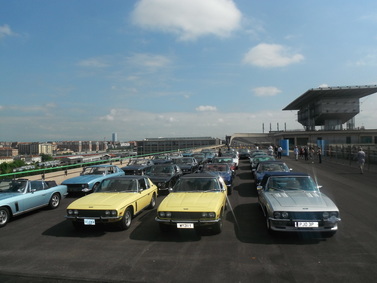
A Jensen CV8 was duly shipped out to the Vignale factory in Turin, where they would remove the fibreglass body, and replace it with a steel monocoque body was attached the CV8 chassis. The new car was ready in 3 months, and 1 month after that, Jensen went to Turin to test drive it, and bring it back to West Bromwich. Two employees, Kevin Beattie and Mike Jones were tasked to bring the new GT back, but were delayed by teething problems at the Vignale factory. This resulted in a mad dash across France, as they had already booked the car onto the air ferry across the channel, and needed to meet this deadline. So in 1966, they actually drove the car non-stop,(apart from fuel and channel crossing) to West Bromwich in just 22 hours.
The car was unveiled at the Motor Show with outstanding success, and was immediately put into production, with the body shells being produced by Vignale and then being shipped to the Jensen factory for fitting up. This proved to be uneconomical, so they transferred the body tooling to West Bromwich for the bodies to be built there, after some 50 Vignale Interceptors being built. Very few of these early cars have survived, and they command a high price when they come on the market.
The car was unveiled at the Motor Show with outstanding success, and was immediately put into production, with the body shells being produced by Vignale and then being shipped to the Jensen factory for fitting up. This proved to be uneconomical, so they transferred the body tooling to West Bromwich for the bodies to be built there, after some 50 Vignale Interceptors being built. Very few of these early cars have survived, and they command a high price when they come on the market.

The trip I, and my 19year old son, embarked on with the club, was to celebrate this drive back, trying to use the route they took 50 years previously, and avoiding motorways as much as possible. It was deemed the official end of the trip would be at Le Touquet airport, where the Interceptor was flown over to Lydd airport, as there would be many continental Interceptors on the trip which would not be going back to the UK.

Wednesday 1st June was D-day, a gentle tootle to Dover, to catch the train the next morning. Originally I had booked the ferry, but had to swap to the tunnel due to the French fuel crisis. We were carrying 30L of petrol just in case, which was the maximum allowed on the train, and no fuel is allowed on the ferry. Anyway the journey proved quite eventful, with the car misbehaving as soon as we got on the motorway. The rev counter stopped working, then my son, Dan pointed out more importantly the fuel gauge was showing empty, I then found out the indicators weren’t working either. After a few more miles, all the electrics came back again and all was good. We were driving through quite a bit of rain, and when it stopped, I switched the wipers off, only for them to carry on going, then stop of their own accord and for the next hour or so, start and stop when they wanted! The next issue was on the M25, the throttle wouldn’t fully return, causing a heart-stopping situation, the first time but then I was aware of it, so compensated for it. The final issue was after filling with fuel at Dover, the fuel flap wouldn’t shut, this car just didn’t want to leave the country. The flap was eventually persuaded to shut, the throttle pedal lubricated, the wipers working properly now, we were ready for the continent.

Thursday 2nd Up early to catch the train, joining up with others doing the trip at the terminal, and then we were on our way. With quite a number of these big engined GTs going onto the train, the fumes inside were a bit heavy, and one of the loading ladies commented that she had never known it so bad. The first stop in France was scheduled for St Omer town centre; this was not only for lunch, but also a place for various groups, on different trains, and from other countries to assemble. Coming into St Omer the electric gremlin raised its head again, so I thought I was the first casualty of the trip. That accolade went to the trip organiser, whose thermostat housing had sprung a leak. Mine turned out to be a faulty fuse, and a new gasket cured Chris’ water leak, all before lunch. After a good lunch, some 13 Interceptors, the Range Rover support car, and a Fiesta (his Interceptor wasn’t ready in time) headed off to Reims for the first night of the trip. At Reims we visited the Grand Prix circuit, with all the cars lined up alongside the pits. Several of the hooligan element amongst us, managed to do 100MPH+ along the finishing straight, and they will remain nameless!!
A few beers were consumed during and after the evening meal, then off to bed as we had a long drive the next day.
A few beers were consumed during and after the evening meal, then off to bed as we had a long drive the next day.

Friday 3rd Next stop Lausanne, Switzerland. A stop off for lunch at a little village, Flavigny-sur-Ozerain, the Chocolat film location, was planned, but I decided that it wasn’t really our cup of tea, so we kept up with the group until Dijon, then went our separate way, to meet up at Lausanne later. We left the AutoRoute just south of Dijon, to take a more leisurely route into Switzerland, via Salins-les-Bains and Pontarlier. Some great A-roads and scenery here, before we hopped over the border, finally stopping for a light snack. It was an uneventful journey to the hotel, just marred by the constant rain we had had since entering France the previous morning. When arriving at the hotel, we were met by the Swiss contingent of the Jensen Owners Club, who wished us to park up alongside theirs and the German cars. The Germans had also joined the tour at this point. They were very welcoming, with free beer being provided by that arm of the club, for much of the night.
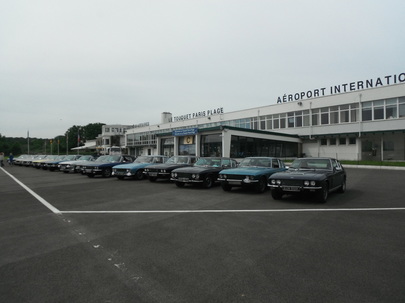
Saturday 4th. We are now some 25 cars, including 2 Jensen CV8s, 1 with a massive 8.2l fuel injected engine, which kept up with the local traffic with ease. First stop is the Chateau de Chillon, built in Lake Geneva, at Montreux, made famous by Lord Byron’s poem The Prisoner of Chillon. A few hours were spent having a guided tour of this fantastic structure, with beautiful views across the lake, but alas we had to depart, as we had a demanding drive over the Alps to Turin. It wasn’t long before we started climbing, and climbing, and climbing. We were heading up the St Bernard Pass, and as we got higher, the temperature gauge also rose, until about a couple of miles before the tunnel, we all pulled over to let the cars cool down a bit. After about half an hour, we were off again, and when you get to the tunnel, there is the choice to go over the pass, or through the tunnel. Some chose to go over the top, and were met with 15ft snow walls each side of the road, as the road had only opened that morning. We chose to go through the tunnel, as I was concerned the drive over the top may be a bit much for the car, and I didn’t want to cause any damage. The tunnel is 2000m above sea level, and 3.5 miles long, but we soon exited on the Italian side, and had a steady descent to the Aosta Valley, through smaller tunnels, where the famous opening scene from The Italian Job was filmed and the Lamborghini Muira was crashed. We duly player On Days Like This by Matt Monroe, and had a quite uneventful, but beautiful drive to Turin, although there was plenty of rain and thunder storms. We followed in convoy through Turin, to cars passing on both sides and plenty of horn blowing for no apparent reason, and finally reaching our destination at the old Fiat factory at Lingotto. We were filmed arriving, Chaos soon ensued as the hotel complex didn’t have sufficient parking, so we basically ended up blocking each other in. For 11 of the cars, it was just a quick check in, a wash, and then off to the Italian National Motor Museum, where they would be put on display in the
foyer. Apparently this was the first time any car club had had this privilege, and they attracted a lot of attention the next day when the museum opened. We all attended a celebratory meal on the evening at the museum, where we had the special guest of Alfredo Vignale’s daughter attending, with the beer and wine flowing freely all night.
foyer. Apparently this was the first time any car club had had this privilege, and they attracted a lot of attention the next day when the museum opened. We all attended a celebratory meal on the evening at the museum, where we had the special guest of Alfredo Vignale’s daughter attending, with the beer and wine flowing freely all night.
Sunday 5th This was a free day and a rest from driving. We attended the museum, and wandered around the beautiful city. Monday 6th We all were excited as from 09:30 we were allowed to access the famous Fiat rooftop test track. The noise of some 30, 6-7 litre V8s, spiralling up the internal road way was intoxicating, and then as if by request the sunshine broke as we got onto the roof. The banked corners are now off limits, only allowing us to drive on the straight sections in between, but it was still a privilege to be up there. There is a 15 KPH speed limit on the roof, needless to say this was exceeded at times, and one owner managed to get all six carb chokes open on his fabled SP version, and reached 80 MPH, in the short distance. After spending a couple of hours up there, I then did a photo shoot with Classic & Sportscar magazine in the afternoon, which was interesting, having to drive 2-3 ft behind a moving vehicle, with the photographer hanging out the back. This is in the November issue, out on 6th October. Next month the return journey, following in the footsteps of the prototype.

The Journey home. Following on from last month’s instalment.
Tuesday 7th June This is what we had all gathered in Turin for, to travel in the footsteps of the 2 Jensen employees, who drove the prototype Interceptor back to the UK in less than 24hrs in June 1966. The idea was to keep to what would have been the actual route trying not to use the Autoroutes, as they weren’t built then. Today’s agenda was to visit the original Vignale factory, have lunch in the Alps, and then make our way to Grenoble for our overnight stop. 19 Interceptors set off from the Lingotto Hotel heading to the northern suburbs of Turin for the Vignale factory, which today is a document storage facility. The original factory gates were opened for us, the first time they had been opened in over 20 years, and we were made very welcome. All the cars were lined up, but one early Interceptor was made up to look like the prototype, with correct number plate, and strategically placed in the exact spot, according to an old photo, where the car was handed over those 50 years ago. We had heard the owner of the factory had his own vehicle collection, but thought we wouldn’t be interested as there wasn’t anything in there as exotic as our cars. We managed to persuade him to let us be the judge, and we were glad he did. He collected mainly utility vehicles and fire engines etc. and we spent 2 hours looking around his stuff, it was an Aladdin’s cave. Amongst some early fire engines, from 1920’s -1970s, including a very strange Fiat amphibious fire engine, there were 3 Fiat 4wheel drive SUVs with Ferrari Dino engines, one of which had actually competed in the Paris –Dakar rally. There was much more but far too much to list here. We had to curtail our impromptu collection viewing as we had lunch booked in the Alps, so we all set off, filling up on the way, so we got split into a number of groups. Just on leaving Turin our group got lost, the 4 of us pulled over just past a junction as we had made a wrong turn. As I was bringing up the rear, this meant I was straddling a Zebra crossing, much to the annoyance of a shopping laden lady who promptly stuck her head through the open driver window and started ranting as only an Italian could. This was of course to the huge amusement of the other drivers. After getting our bearings we headed off for the rendezvous at the top of Col du Mont Cenis, 2083m above sea level. We passed through a beautiful village where there were street entertainers entertaining a group of school children in front of the church, that was until they were rudely interrupted by 4 of us gas guzzlers stealing the limelight. See youtube link https://youtu.be/xVp2zqk4N1U. Eventually we started the climb, and it wasn’t long before some of the cars got hot and bothered and pulled over, to let things cool down, but I soldiered on, actually increasing my speed to try to increase the airflow through the radiator. See youtube link https://youtu.be/fskLAkZ6bsM although my gauge was in the red it was running well and reached the top in one go. The stragglers eventually caught up and a great lunch was had, with fantastic views. The drive down to Grenoble was uneventful, with beautiful views, but we did get stuck in an hour long traffic jam, entering Grenoble. Whilst we were stuck, my son Dan and I were having a great laugh looking at the typically old French cars with a dent in every panel, and bits either taped on or just hanging off. A good meal and a few beers were consumed before a good night sleep.
Wednesday 8th June The cars were garaged securely in the underground garage below the hotel, and this is where we had our first real casualty of the journey. An FF owner struggled to get up the exit ramp, and then found the car’s auto box wouldn’t change out of 1st. After fluid checks, it was deemed terminal and we left Derek and Sue to organise its recovery to the UK. We all set off via the A roads to Chaumont, a good 250miles away. As usual, we all got split into smaller groups, although 3 of us got split from our bigger group on hitting Lyon, where we promptly missed a turn and then got lost. It was when we finally took a wrong turn over a set of traffic lights and onto a Lidl supermarket car park, when we decided to work out a plan, as we had been messing around in Lyon for over an hour. We decided to retrace our route and get on the AutoRoute to
Dijon, then the A roads to Chaumont. This way we may be able to catch up with the others who were way ahead of us at this point. The 3 of us managed to join the AutoRoute, where upon Nigel at the front put his foot down, and we quickly hit 100MPH and kept it there for about 75 minutes, whereupon we filled up and headed off on the A roads again. See youtube link https://youtu.be/yYVPwad8PUo some beautiful scenery and great driving on these roads, and finally arrived at our hotel, which turned out to be very interesting. The hotel would have made Fawlty Towers look like the Ritz, with dated décor, and customer service non-existent, there was even a stuffed moose head in reception! On arrival we checked in and met some earlier arrivals in the bar, only within half an hour the first argument occurred between us and the manager. The bar maid had tried to charge us twice for the same drinks, and had obviously pocketed the money and openly lied to us, but we caught her out. Seeing as there were approximately 40 of us staying, he still refused to open the restaurant, argument number 2, so we had to seek food elsewhere. After eating out we all gathered in the bar, as you do, to be told at 23:00 the bar was shutting, and they started pouring our drinks down the sink, so argument number 3 occurred. It was good to see Derek and Sue there; they had made arrangements for their Jensen to be recovered, and had hired a car to complete the rest of the journey. They turned up late, and the hotel refused to even serve them a sandwich, argument number 4!! Next morning was no better, breakfast tables not being cleared, a lack of plates and cutlery, and I kid you not, loud arguing from the kitchen. We were glad to leave, but the group look back on this place as one of the highlights!!
Tuesday 7th June This is what we had all gathered in Turin for, to travel in the footsteps of the 2 Jensen employees, who drove the prototype Interceptor back to the UK in less than 24hrs in June 1966. The idea was to keep to what would have been the actual route trying not to use the Autoroutes, as they weren’t built then. Today’s agenda was to visit the original Vignale factory, have lunch in the Alps, and then make our way to Grenoble for our overnight stop. 19 Interceptors set off from the Lingotto Hotel heading to the northern suburbs of Turin for the Vignale factory, which today is a document storage facility. The original factory gates were opened for us, the first time they had been opened in over 20 years, and we were made very welcome. All the cars were lined up, but one early Interceptor was made up to look like the prototype, with correct number plate, and strategically placed in the exact spot, according to an old photo, where the car was handed over those 50 years ago. We had heard the owner of the factory had his own vehicle collection, but thought we wouldn’t be interested as there wasn’t anything in there as exotic as our cars. We managed to persuade him to let us be the judge, and we were glad he did. He collected mainly utility vehicles and fire engines etc. and we spent 2 hours looking around his stuff, it was an Aladdin’s cave. Amongst some early fire engines, from 1920’s -1970s, including a very strange Fiat amphibious fire engine, there were 3 Fiat 4wheel drive SUVs with Ferrari Dino engines, one of which had actually competed in the Paris –Dakar rally. There was much more but far too much to list here. We had to curtail our impromptu collection viewing as we had lunch booked in the Alps, so we all set off, filling up on the way, so we got split into a number of groups. Just on leaving Turin our group got lost, the 4 of us pulled over just past a junction as we had made a wrong turn. As I was bringing up the rear, this meant I was straddling a Zebra crossing, much to the annoyance of a shopping laden lady who promptly stuck her head through the open driver window and started ranting as only an Italian could. This was of course to the huge amusement of the other drivers. After getting our bearings we headed off for the rendezvous at the top of Col du Mont Cenis, 2083m above sea level. We passed through a beautiful village where there were street entertainers entertaining a group of school children in front of the church, that was until they were rudely interrupted by 4 of us gas guzzlers stealing the limelight. See youtube link https://youtu.be/xVp2zqk4N1U. Eventually we started the climb, and it wasn’t long before some of the cars got hot and bothered and pulled over, to let things cool down, but I soldiered on, actually increasing my speed to try to increase the airflow through the radiator. See youtube link https://youtu.be/fskLAkZ6bsM although my gauge was in the red it was running well and reached the top in one go. The stragglers eventually caught up and a great lunch was had, with fantastic views. The drive down to Grenoble was uneventful, with beautiful views, but we did get stuck in an hour long traffic jam, entering Grenoble. Whilst we were stuck, my son Dan and I were having a great laugh looking at the typically old French cars with a dent in every panel, and bits either taped on or just hanging off. A good meal and a few beers were consumed before a good night sleep.
Wednesday 8th June The cars were garaged securely in the underground garage below the hotel, and this is where we had our first real casualty of the journey. An FF owner struggled to get up the exit ramp, and then found the car’s auto box wouldn’t change out of 1st. After fluid checks, it was deemed terminal and we left Derek and Sue to organise its recovery to the UK. We all set off via the A roads to Chaumont, a good 250miles away. As usual, we all got split into smaller groups, although 3 of us got split from our bigger group on hitting Lyon, where we promptly missed a turn and then got lost. It was when we finally took a wrong turn over a set of traffic lights and onto a Lidl supermarket car park, when we decided to work out a plan, as we had been messing around in Lyon for over an hour. We decided to retrace our route and get on the AutoRoute to
Dijon, then the A roads to Chaumont. This way we may be able to catch up with the others who were way ahead of us at this point. The 3 of us managed to join the AutoRoute, where upon Nigel at the front put his foot down, and we quickly hit 100MPH and kept it there for about 75 minutes, whereupon we filled up and headed off on the A roads again. See youtube link https://youtu.be/yYVPwad8PUo some beautiful scenery and great driving on these roads, and finally arrived at our hotel, which turned out to be very interesting. The hotel would have made Fawlty Towers look like the Ritz, with dated décor, and customer service non-existent, there was even a stuffed moose head in reception! On arrival we checked in and met some earlier arrivals in the bar, only within half an hour the first argument occurred between us and the manager. The bar maid had tried to charge us twice for the same drinks, and had obviously pocketed the money and openly lied to us, but we caught her out. Seeing as there were approximately 40 of us staying, he still refused to open the restaurant, argument number 2, so we had to seek food elsewhere. After eating out we all gathered in the bar, as you do, to be told at 23:00 the bar was shutting, and they started pouring our drinks down the sink, so argument number 3 occurred. It was good to see Derek and Sue there; they had made arrangements for their Jensen to be recovered, and had hired a car to complete the rest of the journey. They turned up late, and the hotel refused to even serve them a sandwich, argument number 4!! Next morning was no better, breakfast tables not being cleared, a lack of plates and cutlery, and I kid you not, loud arguing from the kitchen. We were glad to leave, but the group look back on this place as one of the highlights!!

Thursday 9th June Off to Abbeville, for the official last night of the tour, another 250mile journey, and about 6 hours drive, plus a trip to a Champagne vineyard for those interested. This wasn’t our cup of tea, so we split up from the group, and made our own leisurely drive to Abbeville, passing through some historic WW1 landscape. We followed the river Somme past Reims and Amiens, before arriving in Abbeville, which is a beautiful town. On the journey we stopped in a layby and had some lunch. Dan and I reflected on the journey, with me asking him whether he had enjoyed himself. He honestly replied at times he had been bored, but on those occasions he had retired to the hotel room, and spent time on the internet socialising, as only a 19 year old can understand. He also said that £1500 it had cost him would have paid for a good holiday somewhere exotic, but overall he was glad he did it, as it was an unrepeatable experience. I was glad and surprised that we had not had any arguments, considering we had spent 10 days together, without a break, and had really got on very well. The hotel in Abbeville could not have been more different from the previous evening. The staff was very helpful, to the point of guiding us to the public carpark, and the specific spaces we could use for free. On the evening was a celebratory dinner, where the last Jensen joined the group. He was from Paris and could only make that one night of the whole tour, due to work and family commitments, but he made it and had only owned his car for 3 months. Much alcohol and food was consumed that evening, and many recounts of each other’s experiences of the trip were given.
Friday 10th June The morning was bright and sunny for our last visit to a point of interest, before catching the 14:20 Chunnel train. We all set off in drips and drabs, depending on your hangover, to Le Touquet, and more specifically the airport. This was where the prototype was driven aboard a Bristol Superfreighter, 50 years to the day, and flown to Lydd airport on the south coast of Kent. We all arrived for a photo shoot in the carpark, 2 latecomers being delayed after being done for speeding, when something unexpected occurred. The airport
authorities were aware that we would be arriving, and they then opened the gates to allow us apron side, in front of the terminal. Bear in mind this is an international airport with customs, and light aircraft taxiing around us, the French can come up trumps occasionally. We were duly all lined up correctly with a man with his ping pong bats, and champagne was drunk to officially end the tour. This was where we all split up, some going back to their home countries, Germany Switzerland, etc., whilst some Brits were staying on in France for a few days, most of us were heading back home or to the Jensen International weekend at Windsor .
We made our final farewells to newly made friends and it was quite an emotional few minutes for many, as we had driven thousands of miles, with hardly any issues, in cars that were 40+ years old and at time driven hard. We then exited the apron in single file to much horn blowing and waving, to all go our separate ways.
All done, we covered 2000 miles, 4 litres of oil, 4 litres of auto fluid, (although most leaked out as I was over filling it) and 115 gallons of super unleaded fuel, and 2 bottles of octane booster. I was really pleased the car returned 17mpg which is really good!! And only cost me £660 in fuel. Oh, don’t forget the fuse!!
I’ve now got the bug, and am looking at driving to Dresden and back next September, no special reason, just a suggestion from one of our German friends, as there are good driving roads out there, with little traffic. 40 hotel rooms already booked, so watch this space.
Friday 10th June The morning was bright and sunny for our last visit to a point of interest, before catching the 14:20 Chunnel train. We all set off in drips and drabs, depending on your hangover, to Le Touquet, and more specifically the airport. This was where the prototype was driven aboard a Bristol Superfreighter, 50 years to the day, and flown to Lydd airport on the south coast of Kent. We all arrived for a photo shoot in the carpark, 2 latecomers being delayed after being done for speeding, when something unexpected occurred. The airport
authorities were aware that we would be arriving, and they then opened the gates to allow us apron side, in front of the terminal. Bear in mind this is an international airport with customs, and light aircraft taxiing around us, the French can come up trumps occasionally. We were duly all lined up correctly with a man with his ping pong bats, and champagne was drunk to officially end the tour. This was where we all split up, some going back to their home countries, Germany Switzerland, etc., whilst some Brits were staying on in France for a few days, most of us were heading back home or to the Jensen International weekend at Windsor .
We made our final farewells to newly made friends and it was quite an emotional few minutes for many, as we had driven thousands of miles, with hardly any issues, in cars that were 40+ years old and at time driven hard. We then exited the apron in single file to much horn blowing and waving, to all go our separate ways.
All done, we covered 2000 miles, 4 litres of oil, 4 litres of auto fluid, (although most leaked out as I was over filling it) and 115 gallons of super unleaded fuel, and 2 bottles of octane booster. I was really pleased the car returned 17mpg which is really good!! And only cost me £660 in fuel. Oh, don’t forget the fuse!!
I’ve now got the bug, and am looking at driving to Dresden and back next September, no special reason, just a suggestion from one of our German friends, as there are good driving roads out there, with little traffic. 40 hotel rooms already booked, so watch this space.


